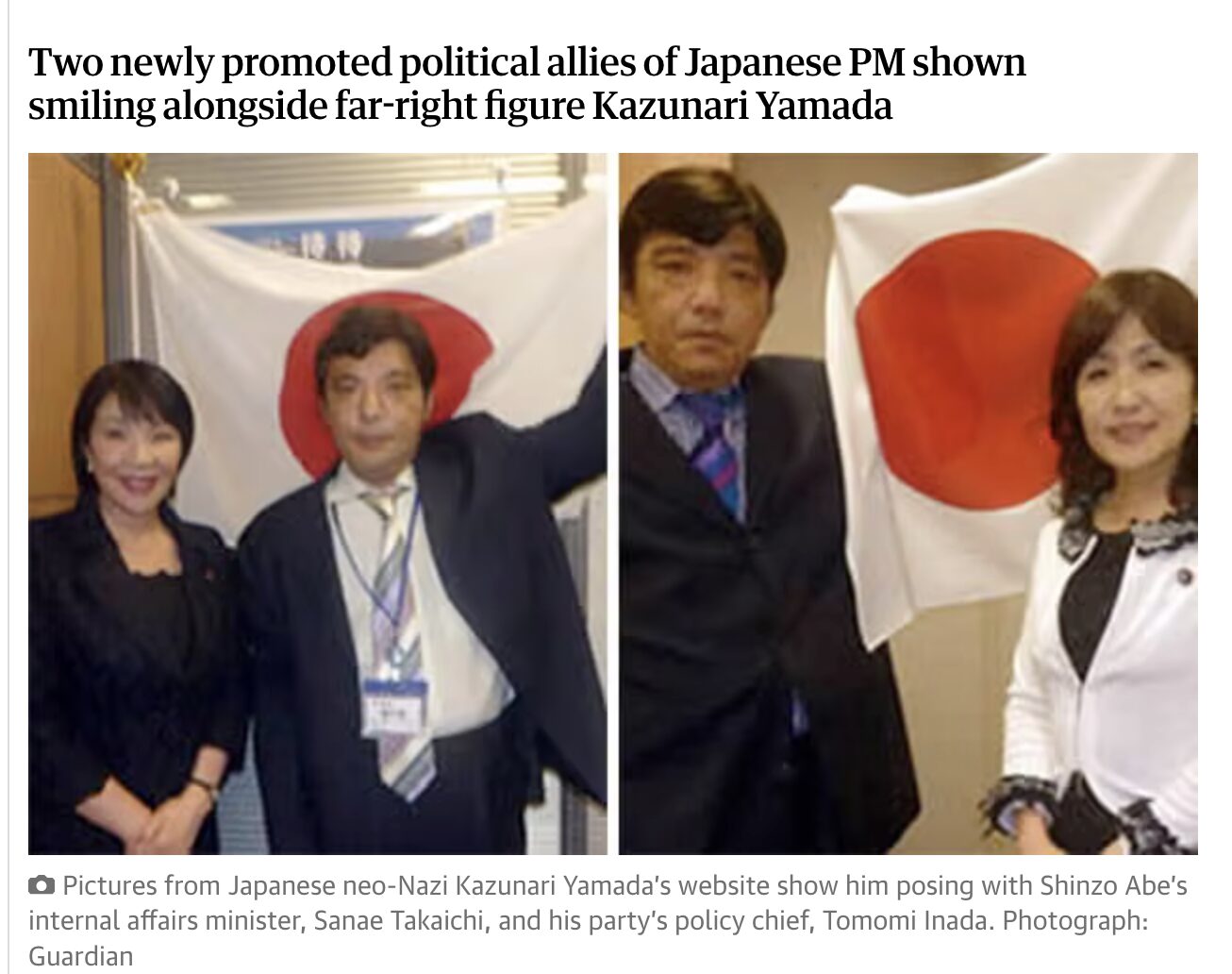by liberal japonicus
wonkie posted an article about a Sanseito rally here, and I appreciate her giving me a reason to rabbit on about this. As a preliminary to writing this, I checked on Mari Yamaguchi, the author of the piece at MuckRack, which leads me to my first caveat. Looking at the link, the article on Sanseito (the name Do It Yourself Party is one that the party uses in literature, but is not the official name) appears in 29 places, while the article in second place, about Ishiba’s resignation, has less than a third. While not conclusive, it seems that a lot of people (or at least newspaper editors) want a story about Japan being anti foreigner. So no shade on Yamaguchi’s reporting, but the eagerness that various outlets have stepped up to discuss this seems very much like epistemic closure.
In the article, Yamaguchi writes
Anti-immigrant policies, which allow populists to vent their dissatisfaction on easy targets, are appealing to more Japanese
While this is true, I was looking for some sort of reporting that gave the number of immigrants. Japan has 3% of its population as immigrant (waves sheepishly). To compare, the US has about 16% while the UK has 18%. There are two ways to take this, the first being that the Japanese have a hair trigger about immigration and immigrants, or that the actual affect is quite small overall so it is performative politics. I lean towards the latter.
The tenor of not only Yamaguchi’s article, but a number of others, is presenting this as a totally unexpected eruption of racism and anti-immigrant feelings. Some have suggested that it is connected to the weak yen, which has allowed popular tourist sites to become overrun with foreign tourists.
You may have read the news that Sanae Takaichi was elected to head the LDP, which is the majority party, though in the recent election (which led to the resignation of Ishiba and thus, the election of Takaichi) they lost the majority and have to coalition with the Komeito party to rule. It would be hilarious if Komeito refused to coalition with the LDP because of Takaichi, though Komeito would have to welcome the idea of Japan’s first female prime minister based on their previous stances.
Thinking about the reasons they (by they, I mean 295 parliamentarians and about 1 million dues paying LDP members, which in the runoff was reduced to one vote from each prefecture, so in the end, you had 392 people deciding who would be the next Prime Minister. And for those of you interested in how the vote went, 149 (Diet members) + 36 (Prefectural chapters) for Takaichi and 145 (Diet members) + 11 (Prefectural chapters) for Koizumi) went with Takaichi, you probably could discard the notion that the parliamentarians wanted to go with a woman. It was half and half and I think a lot of the LDP members must have gritted their teeth to get to that total. Takaichi, who is pretty far on the right, and the other candidate was Shinjiro Koizumi, son of former PM Junichiro Koizumi. He is ‘just’ 44, which may be considered by many as way too young for PM. All the articles tend to argue that the problem was that both father and son are classed on the moderate/liberal side of the LDP and given that the LDP is worried about the DIY party mentioned above, the idea is that you need someone from the right to draw off that support and Takaichi was the most rightward candidate. This might, mirabile dictu, bite them in the butt, because Sanseito skews to young males who might not be too happy that there is a female prime minister, though her positions are as close as one could get to Sanseito. A facebook friend who is a foreign journalist here in Japan posted this, which gives a good précis.
Japan’s new PM is Sanae Takaichi (64) who favors more military spending and legal changes that would allow Japan to attack enemy military bases. She wants to create a law that would punish people who damage the Japanese flag. She supports rolling back what the right in Japan call ‘apology diplomacy’, meaning she thinks Japan has said sorry too much for WW2. She supports official visits to Yasukuni Shrine, which secretly enshrined the men who led Japan into war in the 1930s and 1940s. Her book “Toward a Beautiful, Strong, Growing Nation”, lauds the splendor of the Japanese people and their DNA, unchanged for millennia. She opposes allowing a woman to sit on the Japanese Imperial throne. As communications minister, she threatened broadcasters that were not sufficiently impartial. She injected herself into concerns about growing xenophobia in Japan when she cooked up a story about foreigners abusing deer in Nara which she struggled to make stand up when challenged.
The two things he missed was that she was caught up in one scandal where she was photographed with the leader of the National Socialist Japanese Workers’ Party (NSJAP) (That’s the Japanese Nazi Party for you and me and is the picture at the top) and another where she was promoting a book entitled Hitler’s Election Strategy, A Bible for Certain Victory in Modern Elections, though there were a number of other politicans also photographed promoting the book. It seems like evidence of something that Takaichi (and the female head of policy) were put front and center in the first scandal and I’m pretty sure that there were male LDP members
It’s also telling to me that instead of trying to go with ‘youth’ (though maybe a Gen Y 44 year old talking to Gen Z youth is a bit like Vladimir and Estragon in Godot) they went with Volksgemeinschaft as a way of finding common cause with Sanseito. A lot of reporting about Sanseito seems to suggest that the party came out of nowhere, arising from COVID policies and young disaffected youth, so it isn’t a surprise that they would reach for this. But for me, the fact that they ended up going this route has me thinking that rather than a bolt out of the blue, Japan has always had pretty big rightist streak, and previous Prime Ministers, notably Abe, were much better at keeping the crazies in the tent.
Anyway, that is my take, and I’d be very interested in other foreign takes on Japan’s current politics.


A couple of (practically off topic) thoughts occurred to me while reading this:
First, how many here (who weren’t already familiar with her) read Sanae Takaichi’s name and immediately thought “female”. I’m aware that anyone with a Japanese first name ending with a vowel followed by e (or, especially, ending in ko) will be female. But then, I have friends and family who are ethnic Japanese, so I’m hardly typical.
Second, the whole definition of “immigrant” varies. Even though it consistently carries the connotation of “not from here.” For example (sorry, Hartmut!) someone of Turkish ancestry in Germany will tend to be viewed as not-German, even if the family has been there for several generations. Then there’s California.
Growing up (perhaps still today), you were a real Californian if you were born here, or even moved here with you family when young. Everybody who moved here as an adult was, not exactly “foreign”, but close. Definitely “not from here.” Even if they came here from elsewhere in the US. If you were Hispanic? Hispanics were here a couple of centuries before the first Anglos showed up. So it still depended on whether you were born in California. East Asian? There were still Issei (immigrants from Japan) around, but most ethnic Japanese, and pretty much all ethnic Chinese, were born here — so, all real Californians.
One quick test: there is a city just north of San Diego– La Jolla. Any real Californians will unthinkingly read that as La Hoy-ya. Wereas recent arrivals tend to say La Jol-la. And that applies even to those of us who don’t speak Spanish. We learn to pronounce Spanish words at least approximately correctly just from constant exposure growing up.
It’s remarkable how recurrent the pattern is: a group exists which I will call “Our Nation”. Outsiders move in. At first, when the outsiders are perceived as such a tiny minority as to not make much difference, they are received fairly well; however, as time goes on and more outsiders arrive, a reaction is triggered. The reaction has predictable elements: Our Nation first! Talk about the inherent cultural superiority (and often genetic superiority) of those who are real true members of Our Nation, flag fetishism, militarism, women sidelined out of leadership (unless they can out-hate the male leadership or are physical exemplars of the preferred genotype), the use of Othering to gain power, etc.
I think this territoriality, cult of a strong leader, and fear of the Other is hardwired into our species.
There’s Russian saying, “Man is wolf to man.”
Quite an old one that:
https://en.wikipedia.org/wiki/Homo_homini_lupus
wonkie, I would note that, at least in the US, the pattern has included an additional phase: the group of outsiders is moved into Our Nation, and then a new group of outsiders emerges. Currently the primary group of outsiders seems to be Hispanics. (Arguably it may be more like brown Hispanics. Except that the Spanish language features so prominently.). Before that, it has been Italians, and before that the Irish. At our nation’s founding the boogie man was the Germans.
I won’t be astounded if, down the road, South Asians replace Hispanics as the outsiders of choice. Aided by the difference in religion; Hispanics, at least, are Christians.
Before that, it has been Italians, and before that the Irish. At our nation’s founding the boogie man was the Germans…. I won’t be astounded if, down the road, South Asians replace Hispanics as the outsiders of choice.
I went to high school just west of South Omaha. The sequence of ethnic groups there that became, or are becoming “white” was Irish, Italian, Central/Eastern European, and now Hispanic. Blacks overlapped those at first, but were basically pushed out to the north side of Omaha proper.
My guess is that South Asians don’t become outsiders because there are a lot of them already here in high-skill positions — engineering, medicine, etc. Maybe if there’s a “flood” of poor climate refugees. India, Pakistan, and Bangladesh are 1.9B people in an area that will experience* early climate disasters.
* Arguably, Pakistan already is experiencing them, in the form of now-regular catastrophic monsoon flooding.